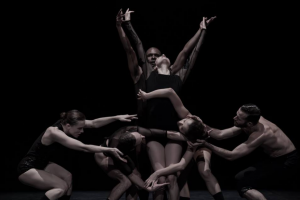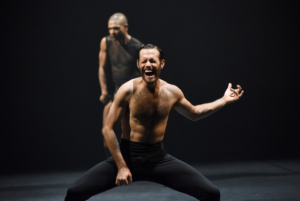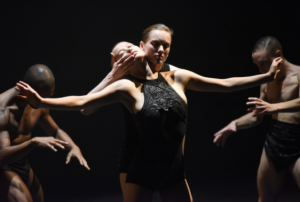Electrifying Dance from Israeli Troupe L-E-V at UCSD
Relentless, brutal, an emotional roller-coaster … That was “OCD Love,” the evening-length piece that L-E-V Dance Company did at Mandeville Auditorium on Thursday night. To a hammering score by Ori Lichtik—a sound artist who’s one of the Israeli troupe’s three creative partners—six dancers occasionally connected and, more often, struggled, creating a society onstage that was high on alienation, short on comfort, and electrifying to watch.

OCD Love
Photo: Ron Kedmi
Some of the thrill came from what makes Israeli contemporary dance in general exciting—the Gaga movement style developed by Batsheva Dance Company’s Ohad Naharin. Gaga is part of the DNA of most Israeli dance artists, and that’s deeply true of L-E-V. The company’s artistic codirector, Sharon Eyal, danced with Batsheva for 18 years, and five of the six dancers are also Batsheva veterans.
In “OCD Love,” whether someone is moving so slowly you can almost see the impulse oozing cell to cell, or a move rips lickety-split through the dancer’s body, there’s an urgency that is Gaga at its best.
 L-E-V also adds elements that make this young company uniquely compelling. While Eyal is a dance artist, her collaborators—Lichtik and artistic codirector Gai Behar—come from the Tel Aviv club scene. And, in both “OCD Love” and “House,” a piece I saw previously, the experience of watching is visceral and, in the best, most thought-provoking way, disturbing.
L-E-V also adds elements that make this young company uniquely compelling. While Eyal is a dance artist, her collaborators—Lichtik and artistic codirector Gai Behar—come from the Tel Aviv club scene. And, in both “OCD Love” and “House,” a piece I saw previously, the experience of watching is visceral and, in the best, most thought-provoking way, disturbing.
Grotesquely beautiful, “OCD Love” features extreme contortions, arms circling behind the back so the hands stick out at either side of the dancer’s waist, nervous twitches that feel like private moments exposed. Some of the men’s costumes, black diapers reminiscent of sumo wrestlers, are another touch of weirdness. (Odelia Arnold, in collaboration with Eyal and several of the dancers, did the costume design.)
In the earlier “House” (2011), human connection seemed impossible. “OCD Love” gives glimpses of something more hopeful—a humorous bit where the dancers line up across the stage and turn their heads in canon, even an almost-kiss. For the most part, though, the outlook is bleak. A man, hand to his chest, seems to offer a woman his heart; then he leaves, and she goes into a twisted, longing reach. Two men carry a plank-stiff woman and use her as a battering ram against another woman.
 Briefly, near the end, the driving percussion in Lichtik’s score takes a rest, and we get melodic cello. The dancers freeze, looking around as if they don’t know what to do. Then they begin doing exercises as if at a ballet barre—perhaps unable to respond naturally to the gentler sound environment and turning, obsessive-compulsively, to a comforting ritual? When the percussion returns, they go into a chain-reaction punch that travels through a couple of dancers and knocks the last one over.
Briefly, near the end, the driving percussion in Lichtik’s score takes a rest, and we get melodic cello. The dancers freeze, looking around as if they don’t know what to do. Then they begin doing exercises as if at a ballet barre—perhaps unable to respond naturally to the gentler sound environment and turning, obsessive-compulsively, to a comforting ritual? When the percussion returns, they go into a chain-reaction punch that travels through a couple of dancers and knocks the last one over.
The name L-E-V comes from the last initials of the three partners, but lev is also Hebrew for heart. At the risk of over-interpreting, with the hyphens between the letters, it’s a heart that’s broken. The world that L-E-V presents onstage is brutal, yet somehow the heart is there, damaged but still alive with the hope for connection—and irresistible.
***
(By the way, the club scene is such a marker of contemporary Israeli society that an acclaimed book about the country’s history and politics, “My Promised Land” by Ari Shavit, devotes a chapter to it. In a review of “House,” I wrote at more length about the connections.)

Award-winning dance journalist Janice Steinberg has published more than 400 articles in the San Diego Union-Tribune, Dance Magazine, the Los Angeles Times, and elsewhere. She was a 2004 New York Times-National Endowment for the Arts fellow at the Institute for Dance Criticism and has taught dance criticism at San Diego State University. She is also a novelist, author of The Tin Horse (Random House, 2013). For why she’s passionate about dance, see this article on her web site, The Tin Horse
